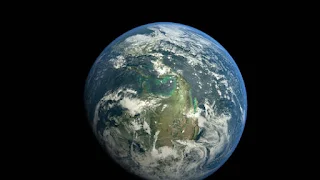Scientists have spent hundreds of years struggling to pinpoint the exact age of the planet, and have come to the typical estimate that our planet is about 4.5 billion years old.
According to scientists, the Earth hides its age well, as most of the Earth's crust is younger than the planet, having been modified throughout Earth's history, to some extent, by plate tectonics and erosion.
How do we know the age of the Earth? We start looking inside it.
"When you're a geoscientist and you look at a rock, it's not just a rock, it's a rock with a story that you can try to decipher," said Becky Flowers, a geologist at the University of Colorado Boulder.
And when minerals form from magma or lava, they often contain traces of radioactive material, such as uranium. Over time, these radioactive elements decay, which means they emit radiation, eventually transforming it into new, more stable elements that remain trapped inside the metal.
Take, for example, radioactive uranium-238, which is a common form of uranium. Its atoms will release energy until they eventually turn into lead. This process occurs at a constant rate known as the half-life, which corresponds to the amount of time it takes for half of the atoms to decay, meaning the time required for half of the substance to decay.
The half-life of uranium-238 is more than 4 billion years, which means that half of the uranium-238 in the sample takes more than 4 billion years to become lead. This makes it an ideal way to date very old things.
By knowing these half-lives, we can calculate the age of a rock based on the ratio of the radioactive element "parent" to the stable element "son" in it, a method called radiometric dating.
Flowers said zircon is a mineral commonly used for radiometric dating because it contains a relatively large amount of uranium.
And uranium-lead dating is just one type of radiometric dating. Others use different elements, for example radiocarbon dating, which is one of the most common methods, uses a radioactive isotope of carbon that has a half-life of thousands of years and is useful for dating organic materials.
Using these methods, geologists have found minerals on Earth dating back 4.4 billion years, which means the planet has existed for at least that long.
But scientists say that the Earth is more than 4.5 billion years old, so where did this extra 100 million years or so come from?
The earth has changed, as we mentioned, a lot over billions of years, especially through processes such as the movement of tectonic plates, which move the crust to the bowels of the earth, bringing new earth out of magma and re-entering the old earth under the earth.
As a result, rocks from the beginning of the planet's history are hard to find, they eroded or melted back into the raw material long ago.
But scientists can use radiometric dating to determine the age of rocks from other parts of the solar system, too. Some meteorites contain materials that are more than 4.56 billion years old, and rocks from the Moon and Mars have been dated to about 4.5 billion years.
These dates are very close to the time when scientists believe that the solar system began to form from the cloud of gas and dust surrounding the nascent sun. And by knowing all these relative ages, we can begin to piece together a timeline of how the Earth, Moon, Mars, and all the other small rocks floating in near space were formed.
However, the transition from the primordial dust cloud to planet Earth did not happen all at once, but over millions of years, said Rebecca Fisher, an Earth and planetary scientist at Harvard University. This means that our understanding of Earth's age will always be less about the exact year the planet was formed and more about a general sense of the age when our home planet first began to take shape.
Tags:
cambridge science
electrical sciences
genomic sciences
geo science
geosciences
life science
live science
neuroscience
science
science magazine
space science
strait of science





Great
ReplyDeleteGreat
ReplyDeleteGood
ReplyDeleteGood
ReplyDelete